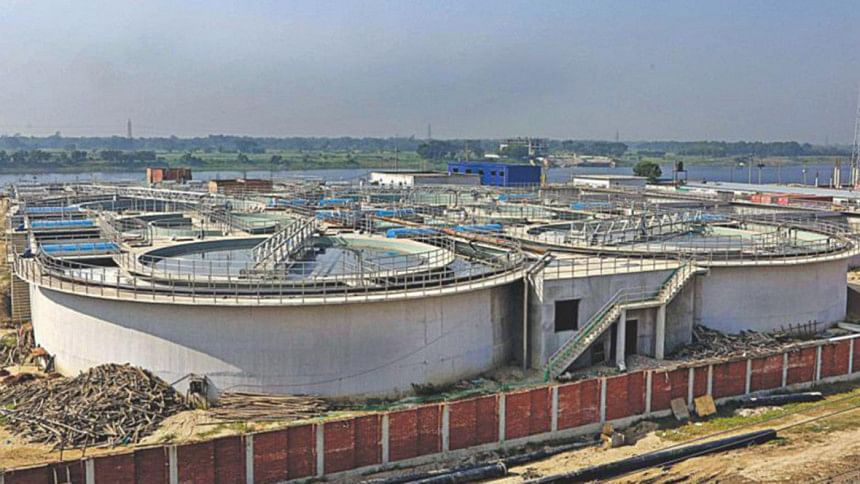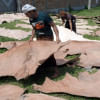Tannery CETP needs renovation even before offering full service

Bangladesh is yet to reap the full benefit from the much-talked central effluent treatment plant (CETP) at the Savar Tannery Industrial Estate (STIE) despite spending more than Tk 500 crore and waiting for nearly a decade.
Yet, it now requires renovation or rebuilding since the contractor that built the facility on the outskirts of the capital city handed over an incomplete CETP.
Now, uncertainty has emerged over who will foot the bill for the necessary work: the government is not keen to provide the fund needed to make the facility fully ready, while the tanners, the users, say they don't have the capacity to fund it.
But without a fully functional CETP, Bangladeshi companies will not be able to obtain the much-required Leather Working Group (LWG) certification, which is a must to attract international retailers and brands in the leather sector.
This means the country will continue to be deprived of valuable foreign currencies since local tanners don't get higher prices for tanned leathers owing to a lack of compliance while finished goods manufacturers can't sell products made using the leather produced in the country.
This is unfortunate for Bangladesh as leather is among a handful of products that offers almost 100 per cent value-addition scope to exporters since raw materials are entirely available locally.
Another price for a lack of a well-equipped CETP is that the environment around the STIE is seen pollution.
This comes as the solid waste management system is not functioning and the plant does not have the capacity to treat all of the rawhides collected during Eid-ul-Azha, an occasion when nearly half of the country's annual animal skins are generated.
As a result, untreated water is being released into the Dhaleshwari river and the local environment due to the overflow at the tank at the CETP, which cost Tk 565 crore.
Currently, the CETP can treat 25,000 to 30,000 cubic metres of liquid waste. But during Eid-ul-Azha, the generation of waste climbs to 45,000 cubic metres as the number of rawhides collected shoots up.
"More than Tk 1,000 crore is needed to make the CETP fully functional," said Mustak Ahmed, managing director of the Dhaka Tannery Industrial Estate Waste Treatment Plant Company (DTIEWTPC), which runs the plant and manages the solid waste generated at the STIE.
He said the CETP needs to be refurbished or replaced as the Chinese company handed over an incomplete plant to the DTIEWTPC in July 2021.
"The CETP is currently running partially. It needs to be refurbished to obtain the LWG certification."
Presently, DTIEWTPC earns Tk 2.25 crore a month from 142 out of 162 tanneries housed inside the estate. Its monthly expenditure stands at more than Tk 2 crore.
Most of the members of the DTIEWTPC board are tanners and the company has a deposit of Tk 5 crore, but the fund is inadequate to renovate or even rebuild the CETP, Ahmed said.
Owing to the partial operation of the CETP, the government has started allowing private ETPs inside the STIE.
Two companies have already obtained permission to set up the facility on their own. Many others have also applied to DTIEWTPC for the same.
Since local tanners don't have the LWG certification and thus can't export leather to developed markets because of poor compliance, they are not getting fair prices, according to Md Shaheen Ahmed, chairman of the Bangladesh Tanners Association.
At present, companies can export tanned leather only to some non-compliant Chinese buyers at rates that are more than 40 per cent lower than global prices.
Bangladesh earned $1.22 billion in the just-concluded fiscal year by selling leather and leather products. But industry people say the leather sector has the potential to earn more.
Shaheen said tanners do not have the capability to spend Tk 1,000 crore to refurbish or rebuild the CETP. "We have already invested more than Tk 10,000 crore at the STIE."
"The government's grant is needed to make the CETP fully functional," he said, adding that seven months would be needed to complete the task.
According to Mustak Ahmed, two companies -- one from Australia and another from Italy – have conducted audits to construct or renovate the CETP.
If one of them is selected either to rebuild or renovate the plant, it will also get the opportunity to run the plant for nearly 15 years since it will have to perform the task using its own funds, he said.
"However, the process is still at a primary stage."
The LWG was formed in 2005 as a collaborative initiative between footwear, apparel and upholstery brands and leather manufacturers. Today, it has become the world's largest leather industry-specific stakeholder organisation, representing over 2,000 stakeholders in more than 60 countries.

 For all latest news, follow The Daily Star's Google News channel.
For all latest news, follow The Daily Star's Google News channel. 





Comments